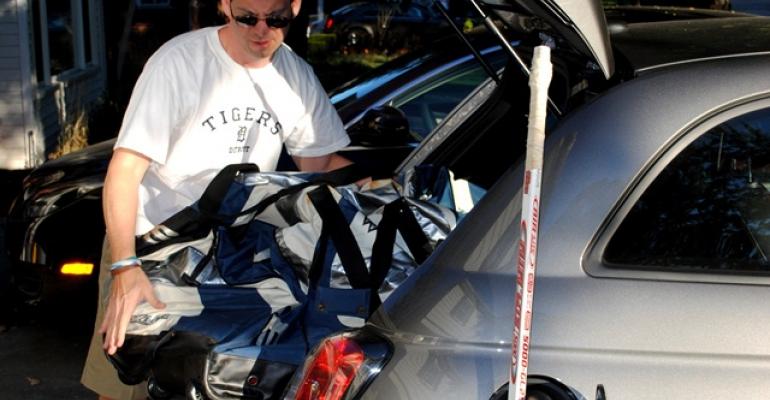The tiny Fiat 500e battery-electric vehicle arrived for Ward’s 10 Best Engines evaluations recently, which means editors have been darting around town in this oddly proportioned 2+2 coupe that is more than 4 ft. (1.2 m) shorter, 2.5 ins. (6.3 cm) taller and 680 lbs. (308 kg) lighter than a Chevrolet Malibu.
My evaluation of the 500e is the most grueling test of all for a subcompact car: I call it the goalie-bag test.
I grew up playing hockey and still don’t mind hard rubber discs flying at my head at blazing speeds. That’s because goalies are well protected, better than when I was a kid, which means the gear is big and bulky enough to make scrawny guys like professional goaltenders Chris Osgood and Jimmy Howard look like offensive linemen.
The Subaru BRZ is a great package as an affordable sports car (and Ward’s 10 Best Engines winner in 2013), but its trunk is about the size of a kitchen sink. Epic fail in the goalie-bag test.
I drove the 500e this past weekend in metro Detroit for three sun-soaked October days that allowed the climate-control system to take the entire weekend off, save for a short run of the heat and defrost on Friday night.
Overall, the $33,095 500e performed magnificently, keeping up with traffic along Woodward Avenue and the expressway. Passing was no problem at all. The near-instantaneous torque gets the tiny car off the line faster than most stock muscle cars.
As a precursor to the goalie-bag saga, I drove 20 miles (32 km) on Sunday from Royal Oak to St. Clair Shores, but used up only 13 miles (21 km) of range, because surface streets allow maximum opportunities to send braking energy back to the battery.
When it was time to drive home to Royal Oak, I took the freeway, knowing I had 88 miles (142 km) of range to burn. And burn I did. The route was less direct, taking 24 miles (37 km), but the speeds approached 90 mph (145 km/h) at times – a velocity that was easy for the powertrain but made the chassis squirrely.
Pushing the traction motor harder than necessary and avoiding regenerative braking, the 500e exited I-696 at Woodward showing 39 miles (63 km) of range remaining. Yes, the trip computer said I’d consumed 49 miles (79 km) of range but had only traveled about 20 miles.
My driving style changed at that point as I was on Woodward with stoplights for 4 miles (6.4 km) and sticking to the speed limits. I arrived home with 44 miles (71 km) remaining: My range actually increased, purely because I was going easy on the accelerator pedal.
Now it was time for the real test: Could a car that barely fits two 10-year-olds in the backseat handle an adult goalie’s gear?
In a word, yes. The rear seats fold flat, and the bag crams in lengthwise, with the goalie pads lying flat on top. The stick fits nicely with the blade in the front passenger footwell. There might even be room for a front passenger.
In truth, passing the goalie-bag test is the least impressive aspect of the 500e. More significant is the simple, straightforward central display that doesn’t bombard the driver with information that tends to incite range anxiety.
Along the left side of the gauge is a green bar that diminishes in size as range is depleted. At the bottom of the gauge is a readout for the number of miles remaining.
The right side has a light bar with three colored tabs that illuminate based on power demand. Normal eco driving (yellow) keeps you in the central tab and braking turns the light blue as it shifts downward to signal energy recuperation. Aggressive driving, with the pedal mashed, lights the top tab red. Ease off, and the light bar falls to the yellow central tab, to signify eco mode.
It’s a brilliant method for coaching efficient driving.
Even a goalie can learn how.





